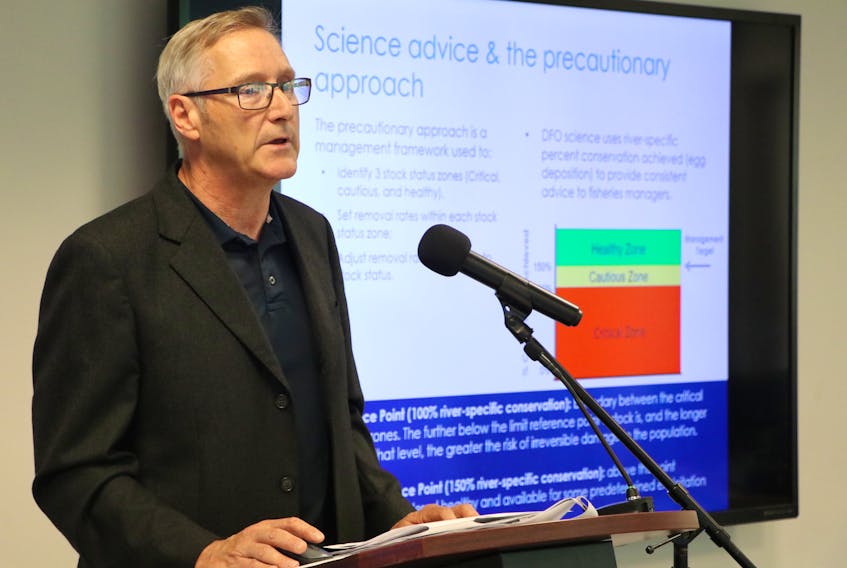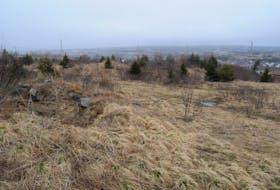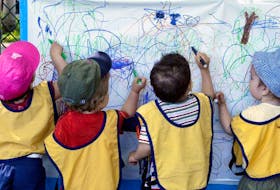The Department of Fisheries and Oceans (DFO) science branch is recommending that all salmon rivers on the island part of the province be closed to retention angling for the remainder of the season due to continued declines in salmon returns found during an in-season stock review.
Catch-and-release angling can continue, it suggests, as long as river water temperatures remain below 18 C. Once water temperatures surpass that mark, catch-and-release should also be halted, the branch says.
DFO research scientist Geoff Veinott said it’s unusual to see declines of the magnitude being experienced on the island part of the province over such a wide geographic range.
“The in-season review showed clearly, as far as we are concerned, that the stocks are continuing to be in some trouble,” Veinott told members of the media Wednesday.
“The returns are down relative to the (time periods) we are interested in, which are the recent five-year (2013-2017 average) and the 2011-2015 (average), which is the period prior to the recent declines. The declines in 2016 and 2017 really, really surprised us, and it was something we had not seen before.”
The in-season review found that six of 11 (54 per cent) of assessed rivers are predicted this year to be below their recent five-year average (2013-17) for the third year in a row. It also showed 27 per cent are predicted to show no significant change while 18 per cent are expected to increase.
In addition, seven of nine rivers are predicted to be below the 2011-15 five-year average, and three out of nine rivers are predicted to be below the 2003-12 10-year average.
“We are seeing declines on almost all of our rivers relative to the 2011-2015 time frame,” Veinott said. “So, in other words, the stocks that are in the healthy (stock status) zone are actually moving down and approaching that healthy/cautious barrier. Stocks in the critical zone are moving down further into the critical zone.”
South coast rivers seem to be those in the most trouble on the island, such as Conne River and Garnish River, he noted.
An in-season review of salmon stocks in Labrador rivers will take place later this month, although Labrador rivers seem generally to do much better.
Veinott said whatever is causing the continuing declines in Atlantic salmon is not happening in the rivers, but occurs after the juvenile fish leave the rivers and begin their long and difficult five-year ocean journey.
“Our juvenile production in fresh water seems to be holding steady. It fluctuates and has been down a little over the last couple of years, but not like you see in term of returns,” he said. “So, what’s happening is our juvenile fish are going out to sea and are simply not returning. We have mortalities on juveniles … in the order of 95 to 98 per cent of our juveniles die when they leave the rivers.
“In a year we have eight per cent sea survival we do quite well, but in a year we have four or five per cent sea survival our rivers are down. The last few years sea survival has been poor.”
Veinott said it is very tricky to determine what exactly causes the high mortality rate at sea. He said scientists have been trying to track the salmon throughout their journey in order to find out.
“These fish that are leaving our waters are very small fish, going out off the Grand Banks, to the Labrador Sea, off the coast of Greenland. Quite an arduous journey for them,” he said. “Once they reach a certain size they seem to survive. We don’t see weak and sick and dying fish coming into our rivers. All seem to be big, healthy Atlantic salmon.”
Veinott noted, however, that not all is doom and gloom, and past experience has shown that things can turn around quickly with salmon stocks.
“If we go back to 2007, we had the worst year on record at the time. But 2008 turned out to be one of the best years on record,” he said. “So whatever is going on in the marine environment that causes this small increase in survival is what determines how well our stocks are going to do. Again, fresh water productivity doesn’t seem to be an issue. We don’t have heavy industry, severe polution issues, so our natural environment is quite healthy for rearing juvenile Atlantic salmon, but once they get out in the marine environment, that’s where we are losing them.”
An announcement by DFO management is expected on Friday about whether the recommendations will be accepted.
Studying hook and release
Gerry Byrne, provincial minister of Fisheries and Land Resources, on Wednesday provided an update on his department’s two-year study on hook-and-release practices on rivers in Newfoundland and Labrador.
The study was first announced in May as a means to help get the best possible science on which to base future hook-and-release regulations.
“A hook-and-release study focusing on Newfoundland and Labrador will establish the first reliable quantitative estimate of Atlantic salmon survival after hook-and-release, define the relationship between environmental variables and hook-and-release survival, identify risk factors in hook-and-release technique, and define the long-term effects of this practice,” Byrne stated in a news release.
The release noted that salmon will be tagged this season and in 2019, and tracked for an entire year to determine both short-term survival immediately after release, and potential long-term effects on survival, spawning and migration.
Radio telemetry tags will be used to track salmon hooked and released under typical conditions in several rivers around the province, with a study site set up at Western Arm Brook.









